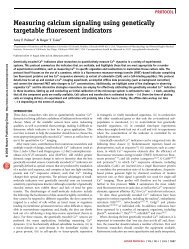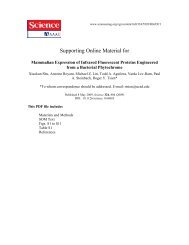THE GREEN FLUORESCENT PROTEIN - Tsien
THE GREEN FLUORESCENT PROTEIN - Tsien
THE GREEN FLUORESCENT PROTEIN - Tsien
You also want an ePaper? Increase the reach of your titles
YUMPU automatically turns print PDFs into web optimized ePapers that Google loves.
536 TSIENby FRET, because at most 50% of the complexes will combine BFP- and GFPlabeledproteins, while nonproductive BFP-BFP and GFP-GFP complexes willeach account for 25% of the homodimers. Nevertheless, careful spectral analysisindicated that homodimerization was detectable by FRET (108). Unfortunately,no modulation of the Pit-1 interaction or new biological conclusionswere reported.Ca 2+ SensitivityThe first dynamically responsive biochemical indicators based on GFP are Ca 2+sensors, independently developed almost simultaneously by Romoser et al (109)and by Miyawaki et al (50). Romoser et al linked commercially available class6 BFP and class 2 GFP mutants with a 26-residue spacer containing the calmodulin(CaM)-binding domain from avian smooth muscle myosin light chain kinase.This spacer allowed FRET to occur from the BFP to the GFP, perhapsbecause it was long and flexible enough for the two GFPs to dimerize. Additionof Ca 2+ -CaM disrupted FRET, presumably by binding to and straightening thelinker so that the two GFPs were unable to dimerize. Such binding of Ca 2+ -CaM decreased the 505 nm emission by 65% and the ratio of 505- to 440-nmemissions by sixfold in vitro, an impressive spectral change for a reversibleconformational change less drastic than proteolytic cleavage. The bacteriallyexpressed recombinant protein was then microinjected into individual HEK-293 cells. In such intact cells, elevations of cytosolic free Ca 2+ producedmuch more modest decreases (5–10%) in 510-nm emission, which could beamplified to about 30% decreases if exogenous calmodulin was co-injected.Thus the response of the indicator in cells was limited by CaM availability, implyingthat the indicator is responsive to cellular Ca 2+ -CaM rather than Ca 2+per se. Because the heterologously expressed protein had to be microinjected,the unique ability of GFP to be continuously synthesized by the target cell wasnot exploited, and only cytosolic signals could be monitored.Miyawaki et al (50) fused BFP or class 5 cyan-fluorescent protein (CFP) tothe N-terminus of CaM, and class 2 GFP or class 4 yellow-fluorescent protein(YFP) to the C-terminus of M13, the CaM-binding peptide from skeletal musclemyosin light chain kinase. The CFP-CaM and the M13-YFP could eitherbe fused via two glycines (in which case all four protein domains were joinedinto a 76-kDa tandem chimera) or left separate. In either case, binding of Ca 2+to the CaM caused it to grab the M13, thus increasing FRET, the oppositespectral effect from that of Romoser et al (109). By using GFPs with mutationsto optimize mammalian expression, the indicators were bright enough to beintroduced into cells by DNA transfection rather than protein microinjection.Because the four-domain chimeras were expressed in situ, they could readily betargeted to organelles such as the nucleus or endoplasmic reticulum by addition






